<< Previous | Displaying results 5001-5050 of 6769 for "" | Next >>
Among the many ironies of the International Military Tribunal was that the defendants were accorded that which they had denied their opponents: the protection of the law and a right to due process. Here, defendant Walther Funk, former German Minister of Economics, speaks with his defense attorney, Dr. Fritz Sauter, in a visitation room at Nuremberg.
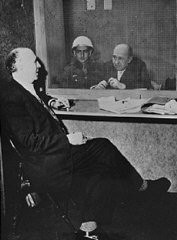
The defendants rise as the judges enter the courtroom at the International Military Tribunal trial of war criminals at Nuremberg.
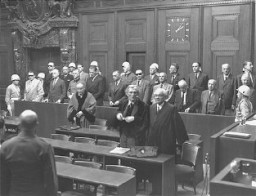
US Chief Prosecuter Robert H. Jackson, pictured at the time of the International Military Tribunal (1945–1946). In 1941, Jackson had been appointed to the US Supreme Court. Justice Jackson took a leave of absence from the court in 1945 to serve as chief US war crimes prosecutor at the Nuremberg trials of former German leaders. He returned to the Supreme Court in 1946.
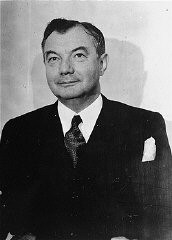
The Soviet prosecution team at the International Military Tribunal. Each of the four Allied countries—the United States, Great Britain, France, and the Soviet Union—was represented by a judge and a team of prosecuting attorneys.
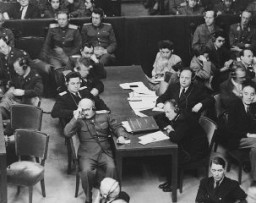
The French prosecution table at the International Military Tribunal trial of war criminals at Nuremberg.
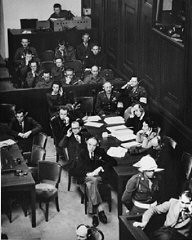
In the International Military Tribunal courtroom, executive trial counsel Colonel Robert G. Storey presents evidence of Nazi intentions to launch an aggressive war.
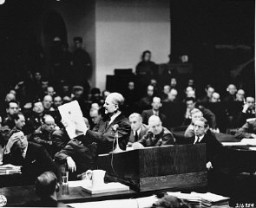
Portrait of Lieutenant Colonel Mervyn Griffith-Jones, British prosecutor at the IMT Nuremberg commission hearings investigating indicted Nazi organizations.
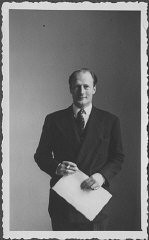
Chief defense attorney Mark O'Conner (standing) addresses a question to John Demjanjuk during Demjanjuk's trial. Jerusalem, Israel, Feburary 16, 1987.

Members of the press during the trial of John Demjanjuk. Jerusalem, Israel, March 18, 1987.
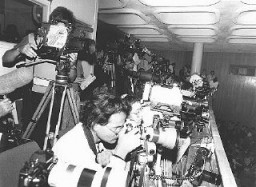
Portrait of Nazi Party official Martin Bormann. Bormann died in an effort to flee Berlin in the last days of World War II, but was long thought to be at large. He was tried in absentia at the International Military Tribunal in Nuremberg, where he was sentenced to death.
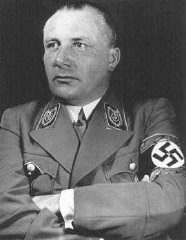
Defendants Karl Dönitz (left), Erich Raeder (center), and Baldur von Schirach under guard in the defendants' dock at Nuremberg.
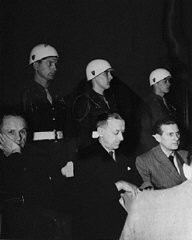
Defendant Hans Fritzsche enters the Nuremberg courtroom under American guard during the International Military Tribunal.
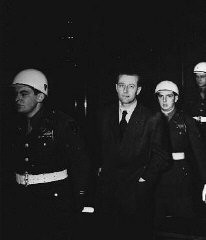
Defendant Alfred Jodl during the International Military Tribunal at Nuremberg. Jodl was Chief of the Armed Forces High Command Operations Staff.
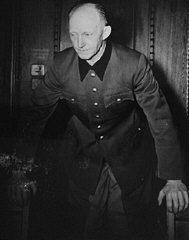
Defendant Ernst Kaltenbrunner during the International Military Tribunal at Nuremberg. He was Chief of the Reich Security Main Office (RSHA) and later Chief of the Security Police.
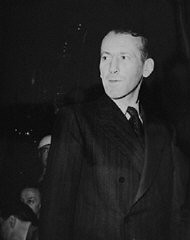
Defendant Wilhelm Keitel, former Chief of the German Armed Forces, in his Nuremberg prison cell.
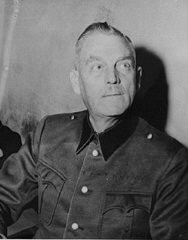
Joachim von Ribbentrop (left), former German Foreign Minister, and Baldur von Schirach (right), former leader of the Hitler Youth, during a recess at the International Military Tribunal.
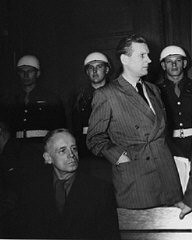
Portrait of Alfred Rosenberg. One of a collection of portraits included in a 1939 calendar of Nazi officials. Germany, 1939.
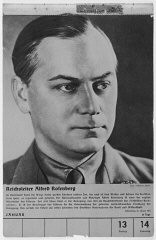
Defendant Alfred Rosenberg, the former chief Nazi Party ideologist, reads a document during the International Military Tribunal trial of war criminals at Nuremberg. Behind him is his co-defendant General Alfred Jodl, formerly the Chief of Staff for the Army. Nuremberg, Germany, 1945–1946.
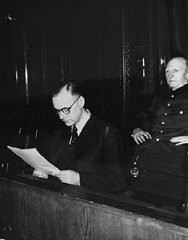
Caricature of Nuremberg International Military Tribunal defendant Alfred Rosenberg, by the German newspaper caricaturist Peis. Nuremberg, Germany, October 1, 1946.
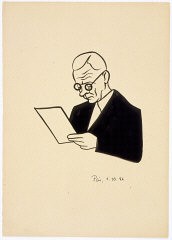
Former Nazi Party ideologist Alfred Rosenberg on trial at the International Military Tribunal war crimes trial. Nuremberg, Germany, April 15, 1946.
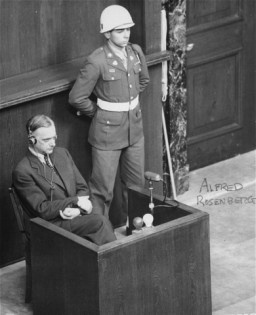
Defendants Wilhelm Keitel (left), Ernst Kaltenbrunner (middle), and Alfred Rosenberg (right), talk during a recess in the proceedings at the International Military Tribunal trial of war criminals at Nuremberg. Nuremberg, Germany, 1945–1946.
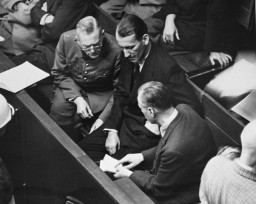
Einsatzstab Rosenberg looted materials of Jewish culture like these books found stacked in the cellar of the Nazi Institute for the Investigation of the Jewish Question. Frankfurt am Main, Germany, July 6, 1945.
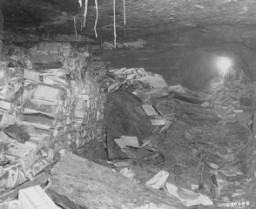
Fritz Sauckel follows the proceedings of the International Military Tribunal trial of war criminals at Nuremberg. He was found guilty of war crimes and crimes against humanity and was sentenced to death. Photograph taken in Nuremberg, Germany, between November 20, 1945, and October 1, 1946.
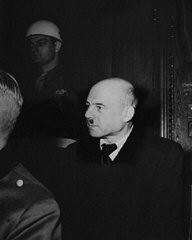
Defendant Albert Speer during the International Military Tribunal trial of war criminals at Nuremberg. Germany, between November 20, 1945, and October 1, 1946.
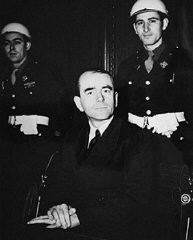
Defendant Julius Streicher, editor of the racist newspaper Der Stuermer. Streicher was one of the MT brought 24 leading German officials charged by the International Military Tribunal at Nuremberg.
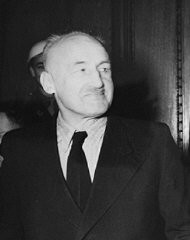
Defendant Julius Streicher, editor of the antisemitic newspaper Der Stürmer, on the stand at the International Military Tribunal trial of major war criminals at Nuremberg. April 29, 1946.
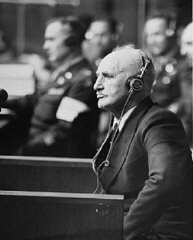
Defendant Julius Streicher in his prison cell at Nuremberg. For his influential role in inciting hatred and violence, the International Military Tribunal at Nuremberg indicated Streicher on count four, crimes against humanity. Streicher was found guilty and sentenced to death. He was hanged on October 16, 1946.
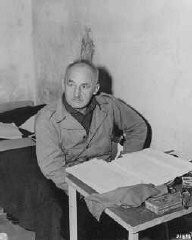
A prosecution witness demonstrates the position prisoners were forced to assume for punishment on the whipping block in the Dachau concentration camp. The Dachau concentration camp trial opened in November 1945. Photograph taken between November 15 and December 13, 1945, Dachau, Germany.
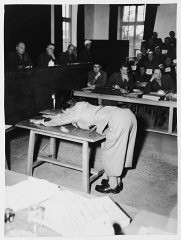
View of the courtroom during the Dachau concentration camp trial. November 15-December 13, 1945.
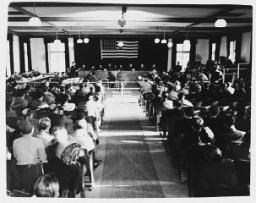
A witness testifies during the Mauthausen concentration camp trial. The man standing in the background is defendant Willy Eckert, a member of the SS. The trial took place before an American Military Tribunal in Dachau, Germany. March-May 1936.
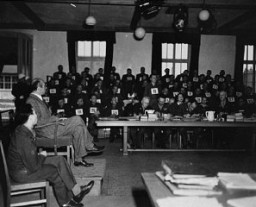
Portrait of Irmgard Huber, chief nurse at the Hadamar euthanasia killing center, in her office. The photograph was taken by an American military photographer on April 7, 1945.
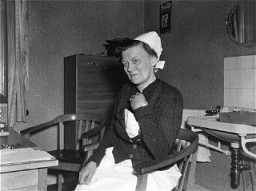
View of the mimeograph room in the Palace of Justice at Nuremberg after the transcripts on the sentencing of the defendants in the High Command Case had been run off. The reproduction of documents during the Nuremberg trials, often in four languages, was a huge logistical challenge. Nuremberg, Germany, 1948. (Source record ID: A65III/RA-121-D)
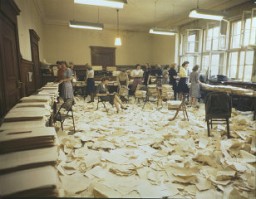
Translators operate an IBM machine during a session of the International Military Tribunal. (Source record ID: A65III/RA-198-D)
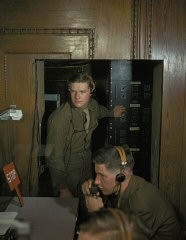
US prosecutor Robert Kempner shows a document to German Field Marshal Erich von Manstein at the International Military Tribunal commission hearings investigating indicted Nazi organizations. Also pictured is the interpreter, a Mrs. Lowenstein. July 1946.
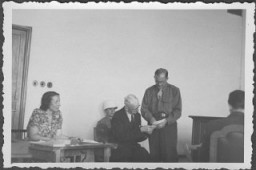
The courtroom where Klaus Barbie, former Gestapo (German Secret State Police) chief in Lyon, was tried on charges of crimes against humanity. Lyon, France, May 1987.
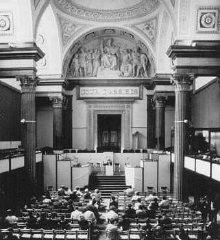
Defendant Adolf Eichmann stands as he is sentenced to death by the court. The execution of Eichmann remains the only time the State of Israel has enacted a death sentence. Jerusalem, Israel, December 15, 1961.
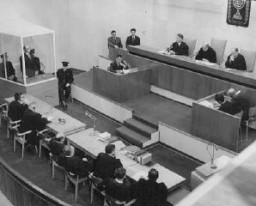
Many journalists covered the trial of Adolf Eichmann in Jerusalem. May 30, 1961.
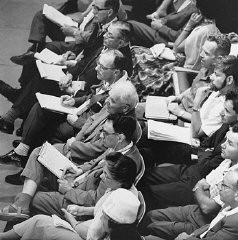
Film evidence is shown during the trial of Adolf Eichmann. Jerusalem, Israel, June 8, 1961.
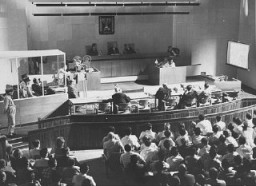
Chief Prosecutor Benjamin Ferencz at the Einsatzgruppen Trial, Case #9 of the Subsequent Nuremberg Proceedings. Photograph taken in Nuremberg, Germany, between July 29, 1947, and April 10, 1948.
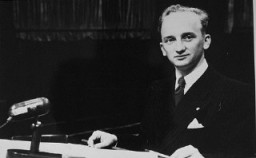
American prosecutor Robert Kempner, at the Nuremberg commission hearings investigating indicted Nazi organizations. July 1946.
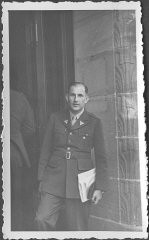
Light cast on architectural details in the Hall of Witness of the United States Holocaust Memorial Museum.
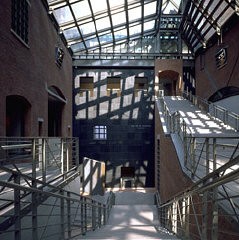
Visitors view the eternal flame in the Hall of Remembrance at the United States Holocaust Memorial Museum.
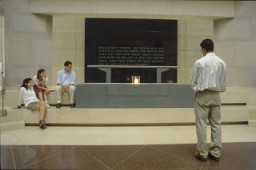
Visitors in the Hall of Witness in the United States Holocaust Memorial Museum. Photograph taken from the Museum's second floor. October 1994.
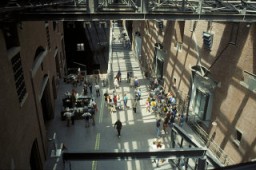
Visitors in the Hall of Witness at the United States Holocaust Memorial Museum. Washington, DC., April 1998.
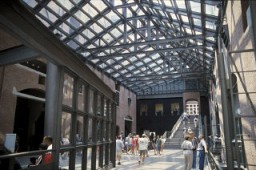
Architectural details in the third floor lounge in the United States Holocaust Memorial Museum.
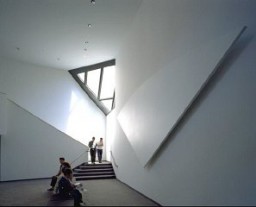
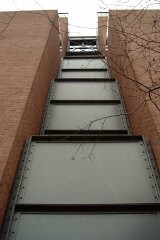
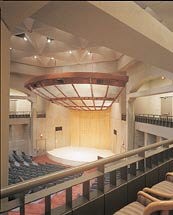
Portrait of James Ingo Freed, architect of the United States Holocaust Memorial Museum. New York, April 1992.
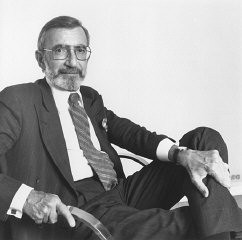
Ernst Toller, German dramatist and revolutionary, emigrated from Germany to other European nations and then to the United States. New York, United States, May 1939.
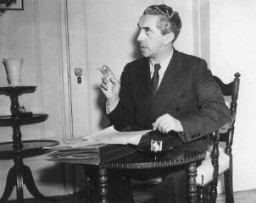
On the day of book burnings in Germany, massive crowds march from New York's Madison Square Garden to protest Nazi oppression and anti-Jewish persecution. New York City, United States, May 10, 1933.
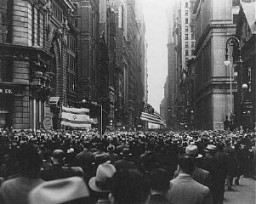
We would like to thank Crown Family Philanthropies, Abe and Ida Cooper Foundation, the Claims Conference, EVZ, and BMF for supporting the ongoing work to create content and resources for the Holocaust Encyclopedia. View the list of donor acknowledgement.